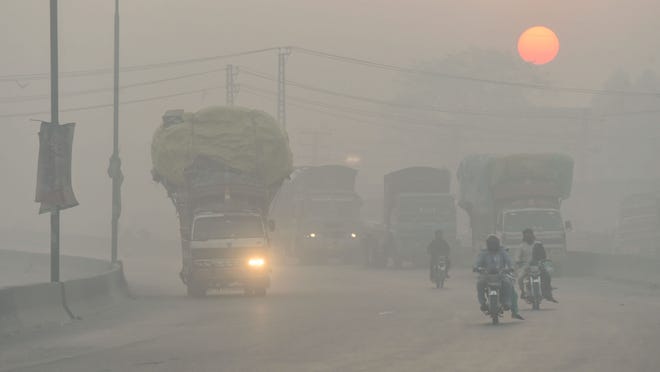A surge in cases on a Virginia lake over Memorial Day weekend is a strong warning to summer sports enthusiasts to use caution and good hygiene at outdoor water spots.
Virginia health officials said 20 people have been diagnosed with E. coli infections and gastrointestinal illnesses after visiting Lake Anna, a recreational facility south of Washington, D.C. Five of the people developed a serious complication called hemolytic uremic syndrome, a rare disease that can damage the kidneys, said Catherine McCombs, deputy director of surveillance and investigations for the Virginia Department of Health's Epidemiology Bureau.
The Virginia case highlights the need for people visiting lakes and recreational waters to be aware of bacterial diseases and other potential dangers that may lurk in the water.
“The water can contain bacteria — not just E. coli, but certainly a variety of other bacteria,” McCombs said.
With summer fast approaching, USA TODAY is taking a look at some of the major water-borne threats that may not be visible to the naked eye.
How often do people get sick from the lake?
Swimming in lakes, rivers, or oceans can expose you to a variety of pathogens.
According to the Centers for Disease Control and Prevention, more than 100 outbreaks have sickened more than 2,700 people since 2009 at outdoor water spots that aren't chlorinated or have filtration systems, and dozens of people have been hospitalized with gastroenteritis and other illnesses at those locations.
People are especially susceptible to lake- and water-borne pathogens during the summer, likely because warmer temperatures lead people to seek out cooler water. According to CDC data, the months most often for people to get sick from lakes and other outdoor water sources are June, July, and August.
According to CDC research, bacterial infections in recreational waters are often caused by pathogens such as norovirus and E. coli. These pathogens can come from human waste, vomit, stormwater runoff, sewage, and malfunctioning septic systems. Animal waste in recreational hotspots can carry pathogens if people swim or play in contaminated waters.
Beware the brain-eating amoeba
Another rare but often deadly risk is the brain-eating amoeba Naegleria fowleri, which a Travis County, Texas, resident contracted and died from last August while swimming in Lake Lyndon B. Johnson outside Austin.
A brain infection called amebic meningitis can develop in freshwater lakes if water gets in through the nose during activities such as diving or waterskiing. Such infections do not usually develop in saltwater or properly maintained, chlorinated swimming pools.
Following the Travis County resident's death, Austin-Travis County Health Officer Dr. Desmar Walks warned residents to be aware of the presence of microorganisms, especially during warmer months, which are “ideal times for harmful microorganisms to grow and reproduce.”
Watery diarrhea and cryptococcus
Pools and hot tubs are generally safer than water play areas because they have filters and chlorinated water, but they can still harbor bacteria depending on how well they are maintained. One study noted that the United States has no national standards for recreational water areas such as pools, hot tubs, and splash pads.
In one case, a New York splash pad became infected with a bacteria called Cryptosporidium, a parasite that causes watery diarrhea, and infected more than 2,300 people. In response to the outbreak, New York state passed public health regulations requiring splash pads to install ultraviolet light systems that kill these microscopic bacteria, according to the CDC.
Chlorine alone doesn't kill this bacteria: Microscopic “crypto” bacteria, which spread through infected people's waste, can survive for a week in water disinfected with chlorine or bromine. Children, pregnant women, and people with weakened immune systems are especially susceptible to infections from this bacteria commonly found in public pools, according to the National Institutes of Health.
Investigation into Virginia lake infection continues
McCombs, of the Virginia Department of Health, said the state is awaiting results from water-quality test samples taken from Lake Anna on Tuesday, tests that typically take about 48 hours to complete.
Health officials also interviewed 20 people with E. coli infections to determine there was no common cause, such as eating the same type of contaminated food or coming into contact with an infected person.
“We're still gathering a lot of information to see if we can rule out any of those factors,” McCombs said.
She said outbreaks of E. coli are often linked to eating contaminated, undercooked food, such as the outbreak caused by romaine lettuce, but contaminated water can also be a source of infection.
“E. coli is thought to be transmitted through food, but it can also be transmitted through water,” McCombs said.
Follow these steps to stay safe when swimming or boating in natural waters
McCombs said people who swim or boat in lakes and other natural bodies of water should avoid swallowing the water.
McCombs also advised that people with cuts or open wounds that could be exposed to bacteria in the water should avoid swimming. People with stomach illnesses or other illnesses that cause vomiting or diarrhea should also avoid swimming, as they could spread bacteria from their bodies to others. McCombs also recommended washing your hands before eating or cooking and after using the toilet if you want to get rid of germs.
Additional tips:
Do not swim near storm drains. Do not swim if you are sick. Do not enter water if there is a green film on the surface. Shower after swimming. Do not swim for three days after heavy rain. Properly dispose of human and dog waste.
Source link




